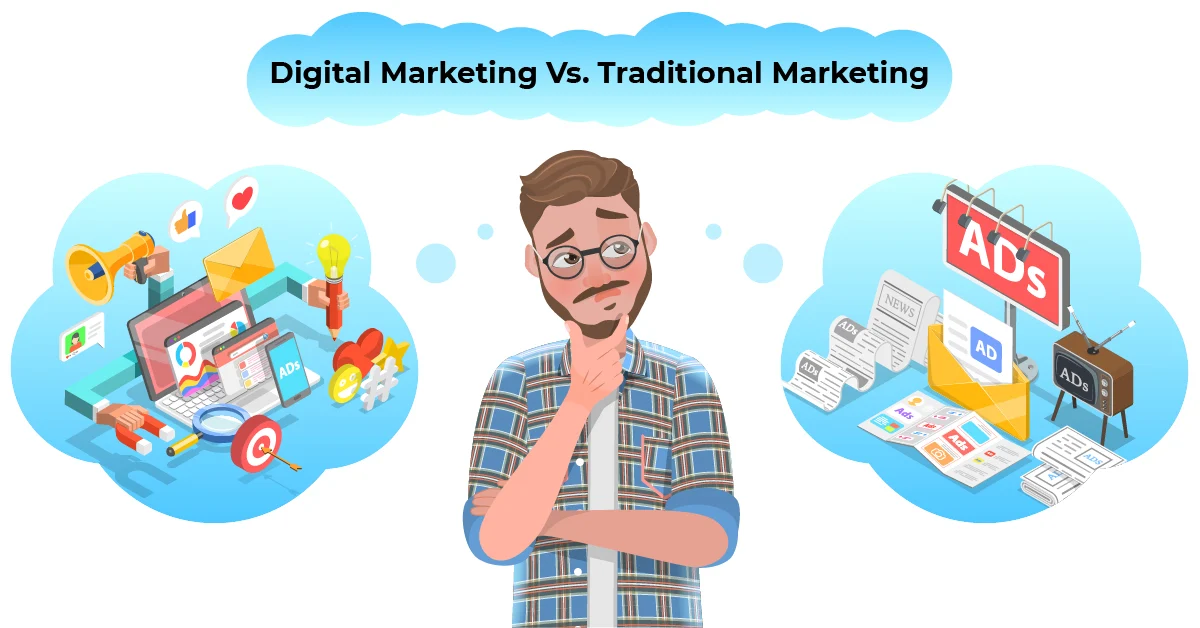In the rapidly evolving world of business, marketing remains a crucial element for success. Companies utilize various marketing strategies to promote their products and services, engage with their target audience, and drive sales. Among the many types of marketing, two prominent ones stand out: Digital Marketing and Traditional Marketing. Each has its unique set of advantages and disadvantages. This blog will delve into both, providing a comprehensive overview to help businesses determine the best approach for their needs.

Chapter 1: Digital Marketing
What is Digital Marketing?
Digital marketing involves promoting products or services using digital channels such as websites, social media, search engines, email, and mobile apps. It leverages the internet and electronic devices to connect with current and potential customers.

Types of Digital Marketing :
- Search Engine Optimization (SEO): Optimizing website content to rank higher in search engine results.
- Content Marketing: Creating and distributing valuable content to attract and engage an audience.
- Social Media Marketing: Using platforms like Facebook, Instagram, and Twitter to promote products and interact with customers.
- Email Marketing: Sending targeted emails to a subscriber list to nurture leads and build customer relationships.
- Pay-Per-Click Advertising (PPC): Paying for ad placement on search engines and other platforms where you pay each time someone clicks on your ad.
- Affiliate Marketing: Partnering with individuals or companies to promote products, paying them a commission for sales generated through their efforts.
- Influencer Marketing: Collaborating with influencers to promote products to their audience.
- Mobile Marketing: Targeting users on their mobile devices through SMS, apps, and mobile-optimized ads.
Advantages of Digital Marketing
Cost-Effectiveness
One of the most significant advantages of digital marketing is its cost-effectiveness. Compared to traditional marketing methods like TV or print ads, digital marketing campaigns can be more affordable. Small businesses with limited budgets can reach a wide audience without breaking the bank.
Targeted Advertising
Digital marketing allows for precise targeting. Businesses can segment their audience based on demographics, interests, behaviors, and more. This ensures that marketing efforts are directed towards individuals who are more likely to be interested in the product or service, increasing the chances of conversion.
Measurable Results
With digital marketing, businesses can track and measure the performance of their campaigns in real-time. Tools like Google Analytics and social media insights provide detailed metrics on various aspects, such as website traffic, engagement rates, and conversion rates. This data allows for quick adjustments and optimization of marketing strategies.
Global Reach
The internet has no geographical boundaries, meaning digital marketing can reach a global audience. This is particularly beneficial for businesses looking to expand their market beyond local or national borders.
Interactivity and Engagement
Digital marketing provides numerous ways to interact with the audience. Social media platforms, for example, allow businesses to engage with customers through comments, messages, and live chats. This two-way communication builds stronger relationships and brand loyalty.
Personalization
Personalization is a key advantage of digital marketing. By leveraging data, businesses can create personalized marketing messages tailored to individual preferences and behaviors. Personalized emails, product recommendations, and targeted ads enhance the customer experience and drive higher engagement.
Disadvantages of Digital Marketing
High Competition
The accessibility and affordability of digital marketing mean that many businesses are vying for the same audience. This high level of competition can make it challenging to stand out and achieve desired results, especially for new or smaller businesses.
Constantly Changing Landscape
Digital marketing trends and technologies evolve rapidly. Staying up-to-date with the latest changes requires continuous learning and adaptation. This can be resource-intensive and overwhelming for businesses without dedicated marketing teams.
Privacy Concerns
With increasing awareness and regulations around data privacy, businesses must navigate complex legal landscapes to ensure compliance. Collecting and using customer data responsibly is crucial, and any breaches can damage a brand’s reputation and lead to legal consequences.
Dependence on Technology
Digital marketing relies heavily on technology and internet access. Technical issues, such as website downtime or software glitches, can disrupt marketing efforts. Additionally, not all target audiences may have equal access to digital channels, limiting reach in certain demographics.
Potential for Negative Feedback
The interactive nature of digital marketing means that customers can easily share their opinions and feedback. Negative reviews or comments on social media can quickly spread and harm a brand’s reputation if not managed properly.
Chapter 2: Traditional Marketing
What is Traditional Marketing?
Traditional marketing encompasses various offline advertising methods that have been used for decades. These include print media (newspapers, magazines), broadcast media (TV, radio), direct mail, outdoor advertising (billboards, flyers), and telemarketing.

Types of Traditional Marketing
- Print Advertising: Ads in newspapers, magazines, brochures, and flyers.
- Broadcast Advertising: TV and radio commercials.
- Direct Mail: Sending physical mail, such as postcards and catalogs, to potential customers.
- Outdoor Advertising: Billboards, posters, and transit ads.
- Event Marketing: Sponsorships and participation in trade shows, conferences, and community events.
- Telemarketing: Making sales calls to potential customers.
Advantages of Traditional Marketing
Wide Reach
Traditional marketing channels, such as TV and radio, can reach a broad audience. This is particularly beneficial for businesses targeting a mass market or older demographics who may not be as active online.
Tangibility
Print media and direct mail have a physical presence that digital media lacks. Tangible materials like brochures and catalogs can be kept for future reference, providing a lasting impression.
Established Trust
Traditional marketing channels often have a long-standing reputation for reliability and trustworthiness. Consumers may trust ads they see on TV or in reputable newspapers more than online ads, which can sometimes be seen as intrusive or spammy.
High Impact
TV and radio commercials can create a high impact through engaging visuals and sound. These mediums allow for creative storytelling, which can leave a strong impression on the audience.
Less Screen Fatigue
In an age where people are constantly bombarded with digital ads, traditional marketing provides a break from screen fatigue. Physical ads, such as billboards or direct mail, can capture attention without the distractions of online browsing.
Disadvantages of Traditional Marketing
High Costs
Traditional marketing methods can be expensive. TV commercials, for example, require significant investment in production and airtime. Print ads and direct mail campaigns also involve substantial costs for materials and distribution.
Limited Targeting
Unlike digital marketing, traditional marketing offers limited targeting capabilities. While certain demographics can be targeted based on the medium’s audience, there is less precision compared to digital channels.
Difficulty in Measuring Results
Measuring the effectiveness of traditional marketing campaigns is challenging. While businesses can track metrics like sales increases and customer feedback, there is no straightforward way to measure engagement or conversion rates from a billboard or print ad.
Limited Interaction
Traditional marketing is mostly one-way communication. There are fewer opportunities for direct interaction and engagement with the audience, making it harder to build relationships and gather immediate feedback.
Declining Reach
The reach of traditional marketing channels is declining as more people shift to digital media consumption. Younger generations, in particular, are less likely to engage with print media or watch TV, reducing the effectiveness of traditional methods.
Conclusion :
Both digital and traditional marketing have their unique advantages and disadvantages. The choice between the two depends on various factors, including your target audience, budget, and business goals.
Digital marketing offers cost-effectiveness, precise targeting, measurable results, global reach, interactivity, and personalization. However, it also comes with high competition, a constantly changing landscape, privacy concerns, dependence on technology, and potential for negative feedback.
Traditional marketing, on the other hand, provides wide reach, tangibility, established trust, high impact, and less screen fatigue. But it also involves high costs, limited targeting, difficulty in measuring results, limited interaction, and a declining reach.
In today’s dynamic marketing environment, a hybrid approach that leverages the strengths of both digital and traditional marketing may be the most effective strategy. By combining the broad reach and trust of traditional marketing with the precision and interactivity of digital marketing, businesses can create comprehensive campaigns that maximize their impact and achieve their marketing objectives.
Ultimately, understanding the nuances of each type of marketing and how they align with your specific business needs will enable you to craft a successful marketing strategy that drives growth and builds a strong, loyal customer base.










